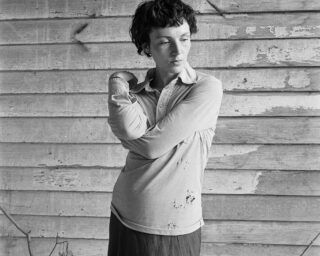Three Women Photographers Reclaim the American Landscape
In her influential 1985 essay “Of Mother Nature and Marlboro Men,” Deborah Bright called for women artists to “recoup landscape photography for themselves in response to its long-time character as an exclusive white male preserve.” The cherished ideal of the Wild West, metaphoric repository of the American dream, seemed particularly hunted and besieged: Ronald Reagan was in office, and images of the cowboy president riding horses and chopping wood on his Santa Barbara ranch were prevalent, propping up stereotypical colonial ideas of dominance and expansion. “Landscape images are the last preserve of a nation’s myths about nature, civilization and beauty,” Bright wrote.
Certainly plenty of American women photographers working in landscape-at-large have been cracking apart those myths since, as seen in Sally Mann’s photographs of Civil War battlefields, and LaToya Ruby Frazier’s depictions of steel industry wastelands in her hometown of Braddock, Pennsylvania, to name a few. In that vein come two auspiciously titled new books of black-and-white photographs centered on American landscape by women photographers: Domesticated Land (MACK, 2018) by Susan Lipper and Manifest (TBW Books, 2018) by Kristine Potter.
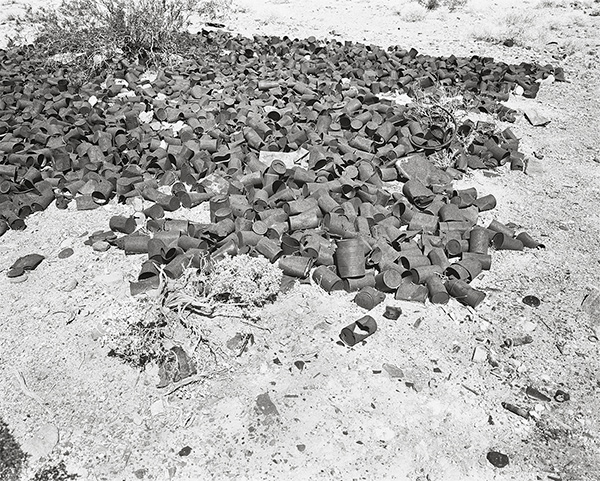
Courtesy the artist and MACK
Lipper’s Domesticated Land is the third in a series of monographs the New York–based photographer has made on road trips in America since the 1990s. In this installment, she travels to the California desert, rendered postapocalyptyic in sun-bleached tones. In the image that wraps the front and back cover of Domesticated Land, a desert junkyard of tin cans rusts in the sunlight, the detritus of past westward migrations leaving an ominous trail for those who follow. While born in Dallas, Potter was based in New York for years, prior to moving to Nashville in 2017. For Manifest, she traveled to Colorado, photographing wilderness and the men who wander it. On the cover of the book, a male subject is mostly camouflaged by leaves and corresponding shadows; they shield and protect him in a harsh and unknown landscape.
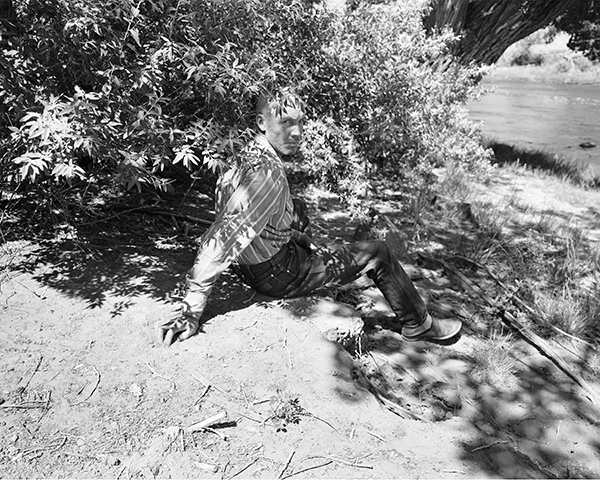
Courtesy the artist and TBW Books
Lipper and Potter focus specifically on the American West. Their books join other recent monographs by women that take as their subject this complicated history and landscape. In her first monograph, Deep Springs (MACK, 2017), begun when she was completing an MFA at Yale, Sam Contis traveled to the then all-male liberal arts college of the same name, located in the California desert east of the Sierra Nevadas. Her sensual, gestural pictures of young men in a rugged landscape reveal atypical depictions of masculinity in the West. In her photographs the region remains romantic, but the view is personal and intimate, focusing not just on bodies in relation to landscape, but specifically the textures of clothing, skin, dirt, blood.

© the artist and courtesy Mitchell-Innes & Nash, New York
Wilderness, the road, and the individualist promise embodied by the West have occupied much of Justine Kurland’s career, too, starting with her Girl Pictures series of staged photographs, which were recently shown in an anniversary exhibition and republished as a limited-edition photobook in an edition of two hundred copies, which sold out rapidly (Mitchell-Innes & Nash, 2018). Seen afresh in 2018 and by a new generation, her girls took on new resonance as they forged through woods and roadside wastelands and made those places their own, reclaiming male-dominated adventure narratives in the process. What began as revisions of fictionalized myth for Kurland launched a career trajectory into a years-long, documentary minded exploration of the American road as place and ideal, an interrogation of manifest destiny.
On her annual cross-country migrations, often accompanied by her young son, Kurland photographed the tropes of the Westward road: trains dissolving into the vast landscape, horses and cars and their mechanics and drivers and hitchhikers—America’s grizzled and troubled dreamers and drifters, most of them and the Contemporary American Landscape men. “What is power in this wounded world?” Kurland asks, quoting her own son’s question; “I could ask the same of the road.”
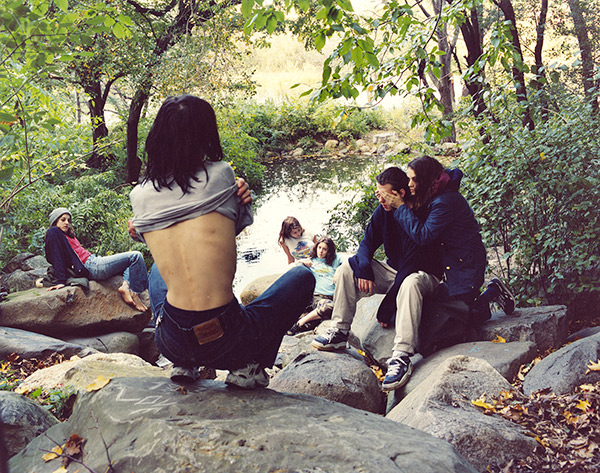
© the artist and courtesy Mitchell-Innes & Nash, New York
The drifters who wander through Kristine Potter’s pages could practically be some of the same men. Potter has made masculinity the subject of previous series: her photographs of soldiers training at West Point are connected to a long line of male relatives who served in the military. Her latest work, photographed in Colorado, is also rooted in personal history—her great-great-grandparents were sharpshooters who started their own traveling show, in the style of Buffalo Bill’s Wild West show—and Manifest grapples with both the history of landscape photography Bright cites, and the legacy of westward expansion, justified by national ideology. “The mythic image of the West abetted the profound and sustained violence required to render this region to the nation, in a process that in turn stripped from the West the lifeworld of its indigenous peoples,” writes Stanley Wolukau-Wanambwa in the afterword.
Potter’s landscapes are luminous but anxious, alluring but frightening. There’s a sense of paranoia in the pacing of Manifest. Darkness offers comfort: shadows shelter those for whom to be exposed means to be vulnerable. Midway through the book, a photograph of an empty road under a full moon, in multiple shades of silver, is the most serene image in the book—here, the night delivers calm. In daylight, appearing like portents on the ground and repeating within Potter’s sequence are images of water, a river, and the mini narrative of a man surfacing in it, attempting to make his way across. Will he make it? There are flashes of the pastoral—a man sunning on a rock in a stream, sunlit weeds, those river rapids—but idyllic nature is often a goal, not the present tense. It is the distant view, in the book’s final image, of the snow-capped Rockies, seen from a still-green part of the country, obscured by other woods, another wilderness to cross first. Here is manifest destiny realized, Potter seems to suggest—or, to answer Bright, the cancer of the Marlboro Man.

Courtesy the artist and TBW Books
When Susan Lipper began her road trip trilogy of photobooks in the 1990s, she had returned from a three-year residency in the UK. Grapevine, first published in 1994 by Cornerhouse, takes its name from a hollow in rural West Virginia, where Lipper made pictures that were both diaristic and documentary. Her next photobook in the series, trip (Dewi Lewis, 2000), worked photographs made in Louisiana, Mississippi, and Texas into an imagined journey that subverted the classic male road trip, and made her own presence a character. Between trip and Domesticated Land, Lipper says, she invented a new photographic persona, not terribly unlike herself: a liberal New Yorker who “has not lost faith in America fulfilling its utopian promise,” and who also seeks to shuck off its consumerist culture. Her protagonist heads to the California desert, culminating at Zabriskie Point, unnamed but resonant nonetheless. Here presented as a kind of final frontier—blighted, scorched, blinding, largely uninhabited—the landscape takes on an alien aspect, and the objects pictured within it offer telling clues.
As in trip, in which Lipper made her own presence palpable on diner plates and motel mirrors, she places herself in the narrative of Domesticated Land. A car’s side mirror is visible at the right edge of one frame, for instance, and these moments where the photographer is seen offer tangible proof that this world is being watched, that someone is bearing witness to what is happening to this dry, cracking earth. Interspersed at intervals throughout the book are pages containing brief quotations, which clue the reader in to the mindset of this traveler, which is aligned with Margaret Atwood’s The Handmaid’s Tale, and a legacy of American women pioneers who, as feminist theorist Annette Kolodny writes in one epigraph within Domesticated Land, tend to approach the harsh land with the goal of “locating a home and a familial human community within a cultivated garden”: a domesticated land. It’s a gentler approach, but still centered around bending landscape to human will—and isn’t that a version of colonial sensibility, too? Instead of the utopia her traveler seeks, Lipper finds the dried pages of a book, littered fragments of construction material, discarded refrigerators and washing machines, baked asphalt, an abandoned house that could be a suburban tract home out of Robert Adams’s The New West—all grim portents. Soldiers and military tanks appear on the horizon; here, seemingly, is the foregone conclusion of the land, the government takeover of the desert.
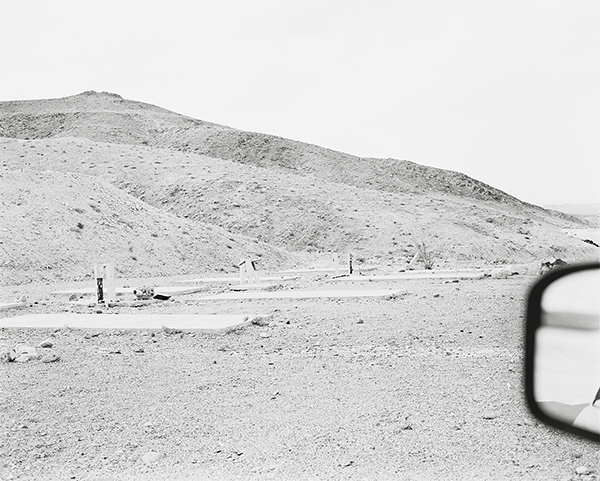
Courtesy the artist and MACK
And yet the book makes room for a kind of hope. Lipper’s lone protagonist is also seemingly rescued by the company of a band of wanderers. Perhaps they are a literal band (she also quotes song lyrics by a desert musical group, the Sibleys), but regardless, their faceless presence in the images adds a welcome mutinous thread as they inspect the traces of civilization. They are the human community of which Kolodny writes, and seeing them delivers a little surge of possibility. Could they collectively rebel against the feds encroaching and imposing an armed rule over the natural world? Some of the solace in the book comes from the bleakness of the images, the depictions of the continuous desert itself, suggestive of something Adams also said in his New West period: that “all land, no matter what has happened to it, has over it a grace, an absolutely persistent beauty.” In any case, if this land is to survive humanity’s most destructive impulses, perhaps a first step is to undo the Marlboro Country mythology of the West: to question, to see again, to see anew.
Read more from The PhotoBook Review Issue 015 or subscribe to Aperture and never miss an issue.













